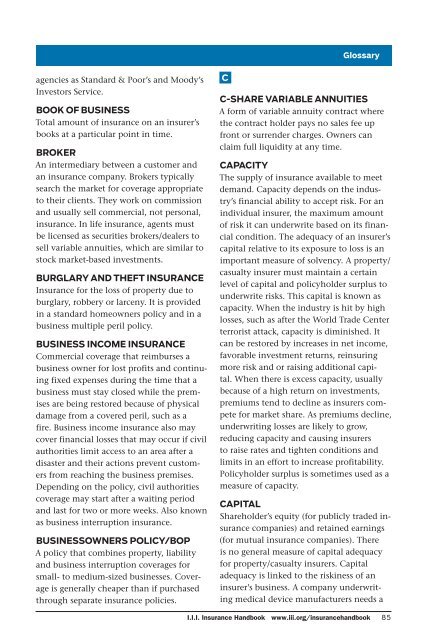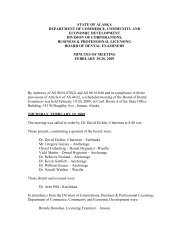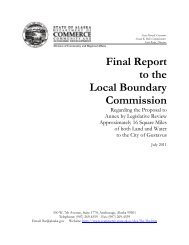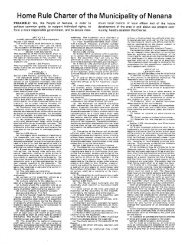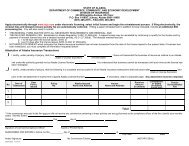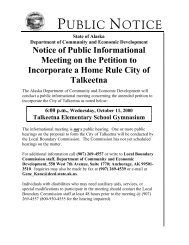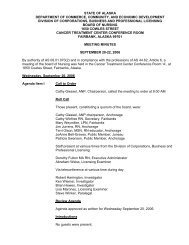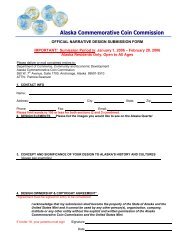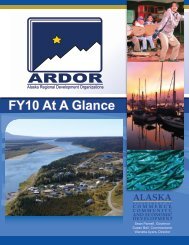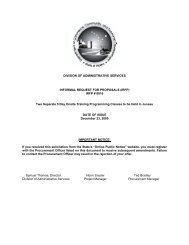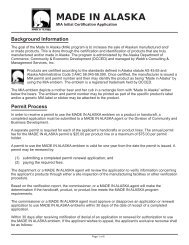Insurance Handbook - Alaska Department of Community and ...
Insurance Handbook - Alaska Department of Community and ...
Insurance Handbook - Alaska Department of Community and ...
You also want an ePaper? Increase the reach of your titles
YUMPU automatically turns print PDFs into web optimized ePapers that Google loves.
agencies as St<strong>and</strong>ard & Poor’s <strong>and</strong> Moody’s<br />
Investors Service.<br />
BOOK OF BUSINESS<br />
Total amount <strong>of</strong> insurance on an insurer’s<br />
books at a particular point in time.<br />
BROKER<br />
An intermediary between a customer <strong>and</strong><br />
an insurance company. Brokers typically<br />
search the market for coverage appropriate<br />
to their clients. They work on commission<br />
<strong>and</strong> usually sell commercial, not personal,<br />
insurance. In life insurance, agents must<br />
be licensed as securities brokers/dealers to<br />
sell variable annuities, which are similar to<br />
stock market-based investments.<br />
BURGLARY AND THEFT INSURANCE<br />
<strong>Insurance</strong> for the loss <strong>of</strong> property due to<br />
burglary, robbery or larceny. It is provided<br />
in a st<strong>and</strong>ard homeowners policy <strong>and</strong> in a<br />
business multiple peril policy.<br />
BUSINESS INCOME INSURANCE<br />
Commercial coverage that reimburses a<br />
business owner for lost pr<strong>of</strong>its <strong>and</strong> continuing<br />
fixed expenses during the time that a<br />
business must stay closed while the premises<br />
are being restored because <strong>of</strong> physical<br />
damage from a covered peril, such as a<br />
fire. Business income insurance also may<br />
cover financial losses that may occur if civil<br />
authorities limit access to an area after a<br />
disaster <strong>and</strong> their actions prevent customers<br />
from reaching the business premises.<br />
Depending on the policy, civil authorities<br />
coverage may start after a waiting period<br />
<strong>and</strong> last for two or more weeks. Also known<br />
as business interruption insurance.<br />
BUSINESSOWNERS POLICY/BOP<br />
A policy that combines property, liability<br />
<strong>and</strong> business interruption coverages for<br />
small- to medium-sized businesses. Coverage<br />
is generally cheaper than if purchased<br />
through separate insurance policies.<br />
C<br />
Glossary<br />
C-SHARE VARIABLE ANNUITIES<br />
A form <strong>of</strong> variable annuity contract where<br />
the contract holder pays no sales fee up<br />
front or surrender charges. Owners can<br />
claim full liquidity at any time.<br />
CAPACITY<br />
The supply <strong>of</strong> insurance available to meet<br />
dem<strong>and</strong>. Capacity depends on the industry’s<br />
financial ability to accept risk. For an<br />
individual insurer, the maximum amount<br />
<strong>of</strong> risk it can underwrite based on its financial<br />
condition. The adequacy <strong>of</strong> an insurer’s<br />
capital relative to its exposure to loss is an<br />
important measure <strong>of</strong> solvency. A property/<br />
casualty insurer must maintain a certain<br />
level <strong>of</strong> capital <strong>and</strong> policyholder surplus to<br />
underwrite risks. This capital is known as<br />
capacity. When the industry is hit by high<br />
losses, such as after the World Trade Center<br />
terrorist attack, capacity is diminished. It<br />
can be restored by increases in net income,<br />
favorable investment returns, reinsuring<br />
more risk <strong>and</strong> or raising additional capital.<br />
When there is excess capacity, usually<br />
because <strong>of</strong> a high return on investments,<br />
premiums tend to decline as insurers compete<br />
for market share. As premiums decline,<br />
underwriting losses are likely to grow,<br />
reducing capacity <strong>and</strong> causing insurers<br />
to raise rates <strong>and</strong> tighten conditions <strong>and</strong><br />
limits in an effort to increase pr<strong>of</strong>itability.<br />
Policyholder surplus is sometimes used as a<br />
measure <strong>of</strong> capacity.<br />
CAPITAL<br />
Shareholder’s equity (for publicly traded insurance<br />
companies) <strong>and</strong> retained earnings<br />
(for mutual insurance companies). There<br />
is no general measure <strong>of</strong> capital adequacy<br />
for property/casualty insurers. Capital<br />
adequacy is linked to the riskiness <strong>of</strong> an<br />
insurer’s business. A company underwriting<br />
medical device manufacturers needs a<br />
I.I.I. <strong>Insurance</strong> <strong>H<strong>and</strong>book</strong> www.iii.org/insuranceh<strong>and</strong>book 85


